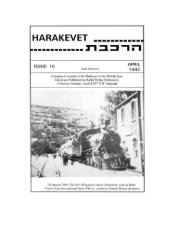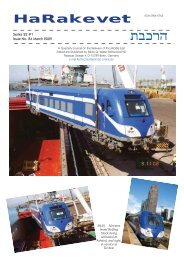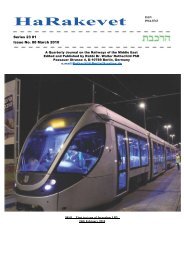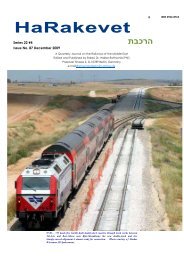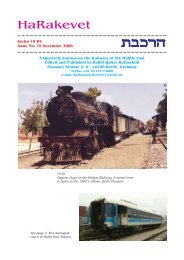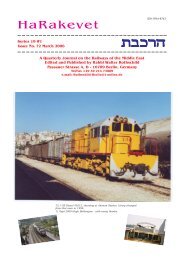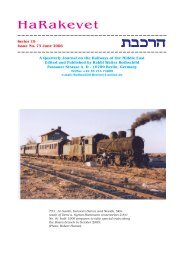Create successful ePaper yourself
Turn your PDF publications into a flip-book with our unique Google optimized e-Paper software.
25D and 27D currently available and operational are well-known. But there were attempts<br />
even earlier to bring diesel traction to Eritrea. In 1939 FIAT/TIBB built four Bo-Bo diesel electrics<br />
for Eritrea (TIBB Nos. 4217-4220, 46 tons, 550 hp, 70km/h.) Due to the war these could not<br />
however be delivered and went instead to Benghazi in Libya (Cyrenaica), where they ran<br />
as 201 - 204. No. 204 was destroyed in 1942 in the conflict, the other three received War<br />
Department numbers WD.706.34 - 36. So - these locos never reached their intended destination.<br />
In 1942 another machine came to Eritrea instead, also due to the war. The remains<br />
of this engine still stand rusting at Mai Atal. It is a FIAT/TL B diesel-electric, 22 tons, 150hp.,<br />
50 km/h. Two of these went (in 1935?) to Tripoli (Libya), TIBB Works Nos. 4066 & 408, and<br />
were numbered A11 and A12 (later War Department WD.706.37 and 38), and two in 1929<br />
to Somalia (incl. TIBB Works No. 4067). Of the engines that went to Somalia, TIBB 4067 was<br />
brought to Massawa by the British Army in 1942 , in order to be used as a mobile generator in<br />
Mai Atal. It stood there next to the tracks and was only re-railed in 2008. The locomotive never<br />
actually worked as such in Eritrea. Last year the leader of the ER Training Centre mentioned that<br />
consideration was being given to installing a new Diesel engine into this locomotive to make it<br />
useable for tourist groups.<br />
(c). ERITREAN MODERNISATION.<br />
In ‘Modelleisenbahner’ 12/2010 pp. 30.33 is an illustrated article by B. Seiler on<br />
modernisation attempts for this line.<br />
(Translation by the Editor).<br />
“Eritrea, at the Horn of Africa, attained its independence only in 1992; in the 30-year<br />
long war of independence the railways of Eritrea were almost wholly destroyed; after the<br />
independence some 118 km. long section from the harbour in Masawa to the capital Asmara<br />
was rebuilt using own resources and the old track materials still available. But it was rebuilt<br />
to the standards of 1920. From 2000 the first trains for railway enthusiasts were run, but the<br />
railway, with some 300 employees, can not even now run regular services. There is a shortage<br />
of almost everything, there is no signalling system, and the maximum axle-loading of the light<br />
rails is 12 tons. Apart from a barely-serviceable Krupp diesel loco from 1957 there are still<br />
several steam locomotives from the 1930’s and a wonderful Fiat railcar named ‘Littorina’ of<br />
1936. Naturally this anachronism fascinates railway enthusiasts from all over the world.<br />
But seems that the days of this ancient atmosphere are numbered. Now it is important<br />
to concentrate on the economic development of this country, still marked by both<br />
the World War anmd the Independence War. This will urgently need some functioning infrastructure.<br />
Near Massawa a new cement factory has been established, which would like - as<br />
soon as possible - to transport 300,000 tons of cement annually to Asmara and beyond. In<br />
the opposite direction several mining companies who are about to start production wish to<br />
transport similar amounts of processed ore to the harbour.<br />
The road conditions in the high mountains are too difficult and the railway also<br />
seemed unsuitable - for the simple reason that the rumour has been spread for years that the<br />
tunnels are two narrow to allow the line to convey containers - in spite of a successful trial run<br />
in 2006. Four years later (in June 2010) railway enthusiasts arranged for a second test run with<br />
a container on a flat wagon. The loading gauge profile turned out to be adequate everywhere.<br />
Eritrea has little foreign exchange and any start into a new railway age is hardly possible without<br />
some support. The Canadian ore producer has offered to pay for five years’ of transport in<br />
advance, but without investion in vehicles, tracks and signalling systems - in amounts into the<br />
millions - a regular daily freight service would be impossible.<br />
At least the fossilised repair workshops will now be modernised thanks to a unique<br />
donation. The Danish State Railways (DSB) closed down their repair workshops in Arhus and<br />
donated the machines and equipment there. The Maersk Line donated two containers and<br />
took over the full cost of transporting them. The idea was that of a railway enthusiast, René<br />
Strandbygarard, the managing director of the Copenhagen Film Company who has good contacts<br />
to both Maersk and DSB, and who had made the acquaintance of this railway on a ‘Far<br />
Rails Tours’ charter trip.<br />
At the invitation of DSB the General Director of the Eritrean Railways, Amanuel Ghebrerelassie,<br />
the head of the Asmara Workshops and a railway engineer travelled in September<br />
2010 first to Denmark, to look at the machines and equipment. But also the know-how for<br />
running scheduled services on a railway that has not been used for three decades needed to<br />
be revived. It was therefore just as important for the delegation to visit a roughly similar railway<br />
and experience it in operation and become informed about current railway operations and<br />
technology. To find such a line, with modern signalling standards and a heavy traffic, was not<br />
exactly easy. The closest fit seemed to be the Harzer Schmalspurbahn (HSB) in Germany. The<br />
staff there, and especially the Chief Controller Jörg Bauer, Deputy Workshops Manager Andreas<br />
Krause and the head of the Customer Service Dept. Silke Stüber gave of their free weekend<br />
time to provide a competent tour of the typical operations and helped the vistors gain an<br />
impression of how things were run. As well as riding the trains they were especially interested<br />
,cfrv<br />
in the permanent way and the signalling, the<br />
automatic spring-loaded points and line and<br />
train radio control systems. Operational Planning,<br />
Training and Safety procedures, Timetable<br />
Planning, Motive Power and Stock planning,<br />
the Centralised Train Control system and<br />
the rolling stock Maintenance (and preventive<br />
maintenance systems) were also inspected.<br />
In the meantime the cargo, worth<br />
some €300,000, set sail. As well as tooling<br />
machines, presses, lifting and welding equipment,<br />
consumable materials such as welding<br />
rods, cranes, lathes and much more, the<br />
donation also includes a complete rerailing<br />
equipment worth alone more than €100,000.<br />
The two containers should arrive at Massawa<br />
at the end of November. Once they have<br />
been transported on to Asmara the machines<br />
will be set up and two State Railway<br />
employees who will fly out especially from<br />
Denmark will assist their Eritrean colleagues<br />
in learning how to operate them. We shall<br />
report on the arrival of the freight to the Red<br />
Sea and its unusual further transportation in a<br />
future issue. (2/2011.)”<br />
Photos include one of the inside of the current<br />
Asmara workshops with 0-4-0T’s, 202.10<br />
pushing a sister loco - “These small machines<br />
are used only for shunting duties and for official<br />
parties in Asmara and Massawa.” Also of<br />
worksplates for two machines currently in the<br />
Asmara workshops, both built in Germany in<br />
1939!<br />
G. ETHIOPIA.<br />
From ‚Railway Gazette‘ 01.10.2010:<br />
„Chinese Funding for Addis Abeba light rail.<br />
The Export and Import Bank of China has<br />
reached agreement with Ethiopian Railway<br />
Corp. to finance the proposed light rail project<br />
in Addis Abeba. A 30km. T-shaped network<br />
is envisaged with one line running from<br />
east to west connecting the Ayat roundabout<br />
with the Torhailoch ring road. The second<br />
route would run from Menelik Square to Merkato<br />
Bus Station, via Sebategna and Abenet,<br />
to link up with the east-west line. The shared<br />
track would continue towards Meskel Square<br />
and south to Akaki. The network is expected<br />
to carry 20,000 daily passengers, relieving<br />
transport congestion in the Ethiopian capital.<br />
<strong>HaRakevet</strong> is typeset and digitally<br />
printed in Leeds, England by<br />
CPS AIredale & Thistle Print Ltd<br />
from copy provided by the editor<br />
in Berlin<br />
0113 226 7497<br />
Page 27



